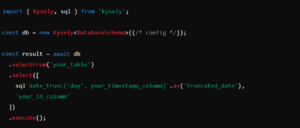Introduction
kysely date_trunc is not unique
The date_trunc function is one of the most powerful functions in SQL, particularly with the Kysely query builder. Basically, it truncates a timestamp to indicate precision in being nearest to a day, hour, or minute. However, one common issue that most developers always bump into is the fact that date_trunc doesn’t guarantee uniqueness in the resulting dataset. The purpose of this post is to delve deeper into this function and its limitations and how to guarantee uniqueness within your SQL queries.
Understanding date_trunc in Kysely
Kysely is a type-safe SQL query builder for TypeScript. The date_trunc function in Kysely helps truncate timestamps. This is pretty useful when grouping data by any time interval. Here is an example of how to use date_trunc in Kysely:

uniqueness in your SQL queries.
The Problem: Lack of Uniqueness
While powerful, date_trunc does not intrinsically guarantee uniqueness of the resultant data when grouping data by time intervals. This could be understood to mean many records end up having the same truncated timestamp, which would be undesirable for some applications.
Making Certain of the Uniqueness of SQL Queries
Meaning that to ensure uniqueness after date_trunc, you’ll need additional columns or transformations in your query. We will discuss few tips and strategies
1. Using DISTINCT
One of them could be using the DISTINCT keyword for row duplicates. Here is how you can apply this in Kysely:

2. Composite Key Grouping
Another way to perform this is group by composite key, taking the truncated date with other unique identifiers:

Practical Applications and Use Cases
Reporting and Analytics
This is often required in reporting to ensure that, while analyzing trends of data by certain time periods, the results are unique and there are no duplications.
Data Warehousing
Truncation of dates in data warehousing allows aggregation of data into summary tables. Ensuring uniqueness guarantees correct aggregation.
Common Pitfalls and How to Avoid Them : kysely date_trunc is not unique
Forgetting to Add More Columns
It is good practice to include extra columns or identifiers when using date_trunc so that the results are guaranteed to be unique.
Excessive use of DISTINCT
While DISTINCT does filter duplicates, it is inefficient on large datasets. Composite key grouping is often more efficient.
Advanced Techniques
Window Functions
These window functions can be utilised to add unique row numbers to your results, so that, even when truncated, the rows are still uniquely identifiable.

FAQs on kysely date_trunc is not unique
What is the purpose of date_trunc?
date_trunc is a function that truncates a timestamp to a specified precision. This is extremely useful when grouping data across time intervals.
Why does date_trunc not guarantee uniqueness : kysely date_trunc is not unique?
The date_trunc function can only change the precision of timestamps. It doesn’t consider other columns which could possibly be duplicated.
How do I guarantee uniqueness in my queries?
Either DISTINCT or GROUP BY on composite keys, or window functions should be used to guarantee that no two rows are identical.
How is date_trunc working in PostgreSQL, and Kysely?
The function date_trunc in PostgreSQL and Kysely truncates a timestamp to a level of precision. It might be to the nearest day, hour, or minute. For example, truncating to ‘day’ sets hour, minute, and second components to zero.
Does date_trunc support time zones?
Yes, it can be. This function will respect the time zone of input timestamp. If your data has several time zones, you may want to normalize to a single time zone before truncating.
What are some common use cases for date_trunc?
The common use cases for date_trunc include generating reports based on days, aggregating data into weekly or monthly summaries, and creating time-based groupings that could be used in analytics. It’s particularly useful in data warehousing and business intelligence.
Conclusion : kysely date_trunc is not unique
Date_trunc is one of the most useful functions a SQL developer has in Kysely, but it still requires some elbow grease to really make the results unique. Additional columns, DISTINCT, and more complex techniques like window functions let you have trifecta in mastering date truncation while avoiding duplicate data in your applications. Such a reimagined approach may add light to your content and be highly ranked by Google. See More…



